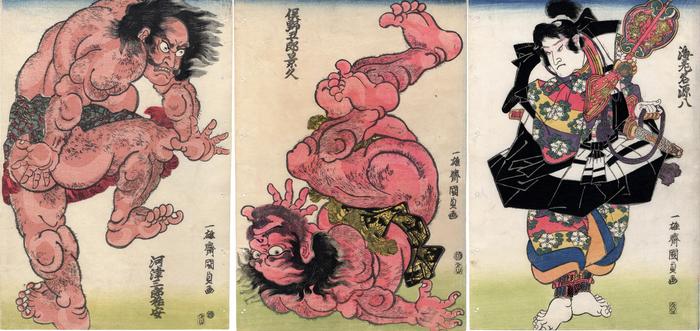Utagawa Kunisada (歌川国貞) / Toyokuni III (三代豊国) (artist 1786 – 01/12/1865)
Kawazu Saburō Sukeyasu (河津三郎祐安) on the left wrestling Matano Gorō Kagehisa (股野五郎景久) in the center, with Ebina Genpachi Hirotsuna (海老名源八弘綱) as referee on the right
ca 1816 – 1817
30 in x 14.5 in (Overall dimensions) Japanese color woodblock print
Signed: Ichiyūsai Kunisada ga
一雄斎国貞画
Publisher: Kawaguchiya Uhei (Marks 232 seal 21-142)
Censor's seal: kiwame
Museum of Fine Arts, Boston
Muzeum Sztuki i Techniki Japońskiej Manggha, Krakow - center panel only
Royal Museums of Art and History, Belgium (via Cultural Japan) - left panel only
Náprstek Museum - right panel only
Mead Art Museum - left panel only
Mead Art Museum - center panel only
Nationaal Museum van Wereldculturen (Rijksmuseum Volkenkunde, Leiden) via Ritsumeikan University - left-hand panel only
Nationaal Museum van Wereldculturen (Rijksmuseum Volkenkunde, Leiden) via Ritsumeikan University - center panel only
Fitzwilliam Museum Illustrated:
1) in color in Sumo and the Woodblock Print Masters by Lawrence Bickford, Kodansha International, 1994, in one of the early unpaginated pages corresponding to page 8. He entitles this: "Legendary Kawazu-Matano bout, with Ebima Gempachi, refereeing. Kawazu throws Matano while Ebina signals the outcome with his fan."
2) in color Catalogue of Japanese Art in the Náprstek Museum published by The International Research Center for Japanese Studies: Nichibunken Japanese Studies Series 4, 1994, p. 79. Right panel only.
3) in black and white in What About Kunisada? by Jan van Doesburg, Huys den Esch, 1990, pages 48-49, plate 13.
****
"Kunisada produced designs for at least three triptychs showing the famous fight between Kawazu and Matano, the present triptych being the second in chronological order, the earliest dates from 1813 or 1814, the latest from around 1840.
The details of the story of the fight vary quite a bit among early Japanese sources. The fight seems to have taken place towards the end of the year 1176, during the reign of the young emperor Takakura Norihito. Matano, a celebrated strong man with some professional wrestling experience, challenged a number of men to individual wrestling bouts and defeated them one by one. According to some sources these men were members of a hunting expedition led by Minamoto Yoritomo. Among them was a certain Kawazu, who at first refused to participate in the bouts, but was persuaded after Matano had defeated the others. Almost immediately after the beginning of the match Kawazu forced his opponent to step backwards and then threw him on the ground, to everyone's amazement. However, Matano claimed that he had tripped backwards over an unseen tree root and he was promised a re-match. Again Kawazu turned out to be the best, although at first he was seized by his loin cloth and lifted from the ground. Almost in lost position he managed to wrap one leg around Matano's and at the same time he pinched his right arm around the latter's neck, creating a technique known as the 'Kawazu-hold' [the kawazu-gake 河津掛] ever since. Matano soon became tired from his exertions and was forcefully thrown on the ground, which is shown in this triptych."
Quoted from: What About Kunisada? by Jan van Doesburg, pp. 48-49.
Kawaguchiya Uhei (川口屋卯兵衛) (publisher)
warrior prints (musha-e - 武者絵) (genre)
sumō (相撲) (genre)
Soga brothers (曾我兄弟) (genre)
